Bibliometric Analysis on Wildfires and Protected Areas
Abstract
1. Introduction
2. Materials and Methods
3. Results
3.1. Documents
3.2. Social Structure
3.3. Authors and Documents
3.4. Conceptual Structure
4. Discussion
5. Conclusions
Supplementary Materials
Author Contributions
Funding
Institutional Review Board Statement
Informed Consent Statement
Data Availability Statement
Acknowledgments
Conflicts of Interest
References
- Handl, G. Declaration of the United Nations Conference on the Human Environment (Stockholm Declaration), 1972 and the Rio Declaration on Environment and Development, 1992; United Nations: New York, NY, USA, 2012. [Google Scholar]
- Hannah, L. Protected Areas and Climate Change. Ann. N. Y. Acad. Sci. 2008, 1134, 201–212. [Google Scholar] [CrossRef] [PubMed]
- De Oliviera Folharini, S.; Nogueira de Melo, S.; Cameron, S.R. Effect of Protected Areas on Forest Crimes in Brazil. J. Environ. Plan. Manag. 2022, 65, 272–287. [Google Scholar] [CrossRef]
- Pisani, D.; Pazienza, P.; Perrino, E.V.; Caporale, D.; De Lucia, C. The Economic Valuation of Ecosystem Services of Biodiversity Components in Protected Areas: A Review for a Framework of Analysis for the Gargano National Park. Sustainability 2021, 13, 11726. [Google Scholar] [CrossRef]
- McNeely, J.A. Protected Areas for the 21st Century: Working to Provide Benefits to Society. Biodivers. Conserv. 1994, 3, 390–405. [Google Scholar] [CrossRef]
- Hannah, L.; Midgley, G.; Andelman, S.; Araújo, M.; Hughes, G.; Martinez-Meyer, E.; Pearson, R.; Williams, P. Protected Area Needs in a Changing Climate. Front. Ecol. Environ. 2007, 5, 131–138. [Google Scholar] [CrossRef]
- Araújo, M.B.; Rahbek, C. How Does Climate Change Affect Biodiversity? Science 2006, 313, 1396–1397. [Google Scholar] [CrossRef]
- Rodrigues, A.S.L.; Andelman, S.J.; Bakarr, M.I.; Boitani, L.; Brooks, T.M.; Cowling, R.M.; Fishpool, L.D.C.; da Fonseca, G.A.B.; Gaston, K.J.; Hoffmann, M.; et al. Effectiveness of the Global Protected Area Network in Representing Species Diversity. Nature 2004, 428, 640–643. [Google Scholar] [CrossRef]
- Chape, S.; Blyth, S.; Fish, L.; Fox, P.; Spalding, M. United Nations List of Protected Areas; United Nations: New York, NY, USA, 2003. [Google Scholar]
- WDPA World Database on Protected Areas. Available online: https://www.protectedplanet.net/en/thematic-areas/wdpa?tab=WDPA (accessed on 15 December 2022).
- Pausas, J.G.; Keeley, J.E. Wildfires and Global Change. Front. Ecol. Environ. 2021, 19, 387–395. [Google Scholar] [CrossRef]
- Tedim, F.; Leone, V.; Amraoui, M.; Bouillon, C.; Coughlan, M.; Delogu, G.; Fernandes, P.; Ferreira, C.; McCaffrey, S.; McGee, T.; et al. Defining Extreme Wildfire Events: Difficulties, Challenges, and Impacts. Fire 2018, 1, 9. [Google Scholar] [CrossRef]
- Bento-Gonçalves, A.; Vieira, A. Wildland Fires. In Wildland Fires: A Worldwide Reality; Nova Science Publishers: Hauppauge, NY, USA, 2015; pp. 3–14. ISBN 978-1-63483-397-4. [Google Scholar]
- Weber, M.G.; Flannigan, M.D. Canadian Boreal Forest Ecosystem Structure and Function in a Changing Climate: Impact on Fire Regimes. Environ. Rev. 1997, 5, 145–166. [Google Scholar] [CrossRef]
- Bento-Gonçalves, A.; Vieira, A.; Úbeda, X.; Martin, D. Fire and Soils: Key Concepts and Recent Advances. Geoderma 2012, 191, 3–13. [Google Scholar] [CrossRef]
- Donthu, N.; Kumar, S.; Mukherjee, D.; Pandey, N.; Lim, W.M. How to Conduct a Bibliometric Analysis: An Overview and Guidelines. J. Bus. Res. 2021, 133, 285–296. [Google Scholar] [CrossRef]
- Aria, M.; Cuccurullo, C. Bibliometrix: An R-Tool for Comprehensive Science Mapping Analysis. J. Informetr. 2017, 11, 959–975. [Google Scholar] [CrossRef]
- Juárez-Orozco, S.M.; Siebe, C.; Fernández y Fernández, D. Causes and Effects of Forest Fires in Tropical Rainforests: A Bibliometric Approach. Trop. Conserv. Sci. 2017, 10, 194008291773720. [Google Scholar] [CrossRef]
- Dos Santos, S.M.B.; Bento-Gonçalves, A.; Vieira, A. Research on Wildfires and Remote Sensing in the Last Three Decades: A Bibliometric Analysis. Forests 2021, 12, 604. [Google Scholar] [CrossRef]
- Zong, X.; Tian, X. Bibliometric Analysis of Fires on Wildland-Urban Interfaces. Nat. Hazards Res. 2022, 2, 147–153. [Google Scholar] [CrossRef]
- Van Eck, N.J.; Waltman, L.; Noyons, E.C.M.; Buter, R.K. Automatic Term Identification for Bibliometric Mapping. Scientometrics 2010, 82, 581–596. [Google Scholar] [CrossRef]
- Zhang, X.; Estoque, R.C.; Xie, H.; Murayama, Y.; Ranagalage, M. Bibliometric Analysis of Highly Cited Articles on Ecosystem Services. PLoS ONE 2019, 14, e0210707. [Google Scholar] [CrossRef]
- Ellegaard, O.; Wallin, J.A. The Bibliometric Analysis of Scholarly Production: How Great Is the Impact? Scientometrics 2015, 105, 1809–1831. [Google Scholar] [CrossRef]
- Bento-Gonçalves, A. Wildfires in the Anthropocene. In Green Marble 2022, Studies on the Anthropocene and Ecocriticism; Mendes, J., Ponce de Leão, I., Bertolami, O., Mendes, M.D.C., Eds.; INfAST—Institute for Anthropocene Studies: Braga, Portugal, 2022. [Google Scholar]
- Romme, W.H.; Despain, D.G. Historical Perspective on the Yellowstone Fires of 1988. Bioscience 1989, 39, 695–699. [Google Scholar] [CrossRef]
- Turner, M.G.; Romme, W.H.; Tinker, D.B. Surprises and Lessons from the 1988 Yellowstone Fires. Front. Ecol. Environ. 2003, 1, 351–358. [Google Scholar] [CrossRef]
- Moritz, M.A. Analyzing Extreme Disturbance Events: Fire in Los Padres National Forest. Ecol. Appl. 1997, 7, 1252. [Google Scholar] [CrossRef]
- Keeley, J.E.; Fotheringham, C.J. Historic Fire Regime in Southern California Shrublands. Conserv. Biol. 2001, 15, 1536–1548. [Google Scholar] [CrossRef]
- Mott, J.A. Wildland Forest Fire Smoke: Health Effects and Intervention Evaluation, Hoopa, California, 1999. West. J. Med. 2002, 176, 157–162. [Google Scholar] [CrossRef] [PubMed]
- Russell-Smith, J.; McCaw, L.; Leavesley, A. Adaptive Prescribed Burning in Australia for the Early 21st Century—Context, Status, Challenges. Int. J. Wildl. Fire 2020, 29, 305. [Google Scholar] [CrossRef]
- Dowdy, A.J. Climatological Variability of Fire Weather in Australia. J. Appl. Meteorol. Climatol. 2018, 57, 221–234. [Google Scholar] [CrossRef]
- Silva, C.A.; Santilli, G.; Sano, E.E.; Laneve, G. Fire Occurrences and Greenhouse Gas Emissions from Deforestation in the Brazilian Amazon. Remote Sens. 2021, 13, 376. [Google Scholar] [CrossRef]
- Mamuji, A.A.; Rozdilsky, J.L. Wildfire as an Increasingly Common Natural Disaster Facing Canada: Understanding the 2016 Fort McMurray Wildfire. Nat. Hazards 2019, 98, 163–180. [Google Scholar] [CrossRef]
- Nauslar, N.; Abatzoglou, J.; Marsh, P. The 2017 North Bay and Southern California Fires: A Case Study. Fire 2018, 1, 18. [Google Scholar] [CrossRef]
- Ribeiro, L.M.; Rodrigues, A.; Lucas, D.; Viegas, D.X. The Impact on Structures of the Pedrógão Grande Fire Complex in June 2017 (Portugal). Fire 2020, 3, 57. [Google Scholar] [CrossRef]
- Turco, M.; Jerez, S.; Augusto, S.; Tarín-Carrasco, P.; Ratola, N.; Jiménez-Guerrero, P.; Trigo, R.M. Climate Drivers of the 2017 Devastating Fires in Portugal. Sci. Rep. 2019, 9, 13886. [Google Scholar] [CrossRef]
- San-Miguel-Ayanz, J.; Durrant, T.; Boca, R.; Libertà, G.; Branco, A.; de Rigo, D.; Ferrari, D.; Maianti, P.; Vivancos, T.A.; Oom, D.; et al. Forest Fires in Europe, Middle East and North Africa; Publications Office of European Union: Luxembourg, 2018. [Google Scholar] [CrossRef]
- Silveira, M.V.F.; Petri, C.A.; Broggio, I.S.; Chagas, G.O.; Macul, M.S.; Leite, C.C.S.S.; Ferrari, E.M.M.; Amim, C.G.V.; Freitas, A.L.R.; Motta, A.Z.V.; et al. Drivers of Fire Anomalies in the Brazilian Amazon: Lessons Learned from the 2019 Fire Crisis. Land 2020, 9, 516. [Google Scholar] [CrossRef]
- Deutsch, S.; Fletcher, R. The ‘Bolsonaro Bridge’: Violence, Visibility, and the 2019 Amazon Fires. Environ. Sci. Policy 2022, 132, 60–68. [Google Scholar] [CrossRef]
- Escobar, H. Amazon Fires Clearly Linked to Deforestation, Scientists Say. Science 2019, 365, 853. [Google Scholar] [CrossRef]
- Ghani, N.A.; Teo, P.-C.; Ho, T.C.F.; Choo, L.S.; Kelana, B.W.Y.; Adam, S.; Ramliy, M.K. Bibliometric Analysis of Global Research Trends on Higher Education Internationalization Using Scopus Database: Towards Sustainability of Higher Education Institutions. Sustainability 2022, 14, 8810. [Google Scholar] [CrossRef]
- Alavifard, S. Hindexcalculator: H-Index Calculator Using Data from a Web of Science (WoS) Citation Report. R Package Version 1.0.0. 2015. Available online: https://cran.r-project.org/web/packages/hindexcalculator/index.html (accessed on 10 January 2023).
- Cobo, M.J.; López-Herrera, A.G.; Herrera-Viedma, E.; Herrera, F. An Approach for Detecting, Quantifying, and Visualizing the Evolution of a Research Field: A Practical Application to the Fuzzy Sets Theory Field. J. Informetr. 2011, 5, 146–166. [Google Scholar] [CrossRef]
- Smit, I.P.J.; Asner, G.P.; Govender, N.; Kennedy-Bowdoin, T.; Knapp, D.E.; Jacobson, J. Effects of Fire on Woody Vegetation Structure in African Savanna. Ecol. Appl. 2010, 20, 1865–1875. [Google Scholar] [CrossRef]
- Levick, S.R.; Asner, G.P.; Kennedy-Bowdoin, T.; Knapp, D.E. The Relative Influence of Fire and Herbivory on Savanna Three-Dimensional Vegetation Structure. Biol. Conserv. 2009, 142, 1693–1700. [Google Scholar] [CrossRef]
- Fisher, J.T.; Erasmus, B.F.N.; Witkowski, E.T.F.; van Aardt, J.; Asner, G.P.; Wessels, K.J.; Mathieu, R. Management Approaches of Conservation Areas: Differences in Woody Vegetation Structure in a Private and a National Reserve. S. Afr. J. Bot. 2014, 90, 146–152. [Google Scholar] [CrossRef]
- Armenteras, D.; Cabrera, E.; Rodríguez, N.; Retana, J. National and Regional Determinants of Tropical Deforestation in Colombia. Reg. Environ. Change 2013, 13, 1181–1193. [Google Scholar] [CrossRef]
- Armenteras, D.; González, T.M.; Retana, J. Forest Fragmentation and Edge Influence on Fire Occurrence and Intensity under Different Management Types in Amazon Forests. Biol. Conserv. 2013, 159, 73–79. [Google Scholar] [CrossRef]
- Armenteras, D.; Schneider, L.; Dávalos, L.M. Fires in Protected Areas Reveal Unforeseen Costs of Colombian Peace. Nat. Ecol. Evol. 2018, 3, 20–23. [Google Scholar] [CrossRef] [PubMed]
- Alvarado, S.T.; Silva, T.S.F.; Archibald, S. Management Impacts on Fire Occurrence: A Comparison of Fire Regimes of African and South American Tropical Savannas in Different Protected Areas. J. Environ. Manag. 2018, 218, 79–87. [Google Scholar] [CrossRef] [PubMed]
- Beale, C.M.; Courtney Mustaphi, C.J.; Morrison, T.A.; Archibald, S.; Anderson, T.M.; Dobson, A.P.; Donaldson, J.E.; Hempson, G.P.; Probert, J.; Parr, C.L. Pyrodiversity Interacts with Rainfall to Increase Bird and Mammal Richness in African Savannas. Ecol. Lett. 2018, 21, 557–567. [Google Scholar] [CrossRef] [PubMed]
- Archibald, S.; Nickless, A.; Govender, N.; Scholes, R.J.; Lehsten, V. Climate and the Inter-Annual Variability of Fire in Southern Africa: A Meta-Analysis Using Long-Term Field Data and Satellite-Derived Burnt Area Data. Glob. Ecol. Biogeogr. 2010, 19, 794–809. [Google Scholar] [CrossRef]
- Schmidt, I.B.; Moura, L.C.; Ferreira, M.C.; Eloy, L.; Sampaio, A.B.; Dias, P.A.; Berlinck, C.N. Fire Management in the Brazilian Savanna: First Steps and the Way Forward. J. Appl. Ecol. 2018, 55, 2094–2101. [Google Scholar] [CrossRef]
- Eloy, L.; Schmidt, I.B.; Borges, S.L.; Ferreira, M.C.; dos Santos, T.A. Seasonal Fire Management by Traditional Cattle Ranchers Prevents the Spread of Wildfire in the Brazilian Cerrado. Ambio 2019, 48, 890–899. [Google Scholar] [CrossRef]
- Eloy, L.A.; Bilbao, B.; Mistry, J.; Schmidt, I.B. From Fire Suppression to Fire Management: Advances and Resistances to Changes in Fire Policy in the Savannas of Brazil and Venezuela. Geogr. J. 2019, 185, 10–22. [Google Scholar] [CrossRef]
- Eloy, L.; Aubertin, C.; Toni, F.; Lúcio, S.L.B.; Bosgiraud, M. On the Margins of Soy Farms: Traditional Populations and Selective Environmental Policies in the Brazilian Cerrado. J. Peasant Stud. 2016, 43, 494–516. [Google Scholar] [CrossRef]
- Dos Santos, A.C.; da Rocha Montenegro, S.; Ferreira, M.C.; Barradas, A.C.S.; Schmidt, I.B. Managing Fires in a Changing World: Fuel and Weather Determine Fire Behavior and Safety in the Neotropical Savannas. J. Environ. Manag. 2021, 289, 112508. [Google Scholar] [CrossRef]
- Santos, F.L.M.; Nogueira, J.; de Souza, R.A.F.; Falleiro, R.M.; Schmidt, I.B.; Libonati, R. Prescribed Burning Reduces Large, High-Intensity Wildfires and Emissions in the Brazilian Savanna. Fire 2021, 4, 56. [Google Scholar] [CrossRef]
- Schmidt, I.B.; Fidelis, A.; Miranda, H.S.; Ticktin, T. How Do the Wets Burn? Fire Behavior and Intensity in Wet Grasslands in the Brazilian Savanna. Braz. J. Bot. 2017, 40, 167–175. [Google Scholar] [CrossRef]
- Fidelis, A.; Alvarado, S.; Barradas, A.; Pivello, V. The Year 2017: Megafires and Management in the Cerrado. Fire 2018, 1, 49. [Google Scholar] [CrossRef]
- Parr, C.L.; Brockett, B.H. Patch-Mosaic Burning: A New Paradigm for Savanna Fire Management in Protected Areas? Koedoe 1999, 42, a237. [Google Scholar] [CrossRef]
- Parr, C.L.; Chown, S.L. Burning Issues for Conservation: A Critique of Faunal Fire Research in Southern Africa. Austral. Ecol. 2003, 28, 384–395. [Google Scholar] [CrossRef]
- Murphy, B.P.; Andersen, A.N.; Parr, C.L. The Underestimated Biodiversity of Tropical Grassy Biomes. Philos. Trans. R. Soc. B Biol. Sci. 2016, 371, 20150319. [Google Scholar] [CrossRef]
- Veldhuis, M.P.; Ritchie, M.E.; Ogutu, J.O.; Morrison, T.A.; Beale, C.M.; Estes, A.B.; Mwakilema, W.; Ojwang, G.O.; Parr, C.L.; Probert, J.; et al. Cross-Boundary Human Impacts Compromise the Serengeti-Mara Ecosystem. Science 2019, 363, 1424–1428. [Google Scholar] [CrossRef]
- Smit, I.P.J.; Archibald, S. Herbivore Culling Influences Spatio-temporal Patterns of Fire in a Semiarid Savanna. J. Appl. Ecol. 2019, 56, 711–721. [Google Scholar] [CrossRef]
- Van Wilgen, B.W.; Govender, N.; Smit, I.P.J.; MacFadyen, S. The Ongoing Development of a Pragmatic and Adaptive Fire Management Policy in a Large African Savanna Protected Area. J. Environ. Manag. 2014, 132, 358–368. [Google Scholar] [CrossRef]
- Van Wilgen, B.W. Evidence, Perceptions, and Trade-Offs Associated with Invasive Alien Plant Control in the Table Mountain National Park, South Africa. Ecol. Soc. 2012, 17, art23. [Google Scholar] [CrossRef]
- Van Wilgen, B.W.; Forsyth, G.G.; De Klerk, H.; Das, S.; Khuluse, S.; Schmitz, P. Fire Management in Mediterranean-Climate Shrublands: A Case Study from the Cape Fynbos, South Africa. J. Appl. Ecol. 2010, 47, 631–638. [Google Scholar] [CrossRef]
- Van Wilgen, B.W.; Biggs, H.C. A Critical Assessment of Adaptive Ecosystem Management in a Large Savanna Protected Area in South Africa. Biol. Conserv. 2011, 144, 1179–1187. [Google Scholar] [CrossRef]
- Powell, S.L.; Hansen, A.J.; Rodhouse, T.J.; Garrett, L.K.; Betancourt, J.L.; Dicus, G.H.; Lonneker, M.K. Woodland Dynamics at the Northern Range Periphery: A Challenge for Protected Area Management in a Changing World. PLoS ONE 2013, 8, e70454. [Google Scholar] [CrossRef]
- Reed-Dustin, C.M.; Mata-González, R.; Rodhouse, T.J. Long-Term Fire Effects on Native and Invasive Grasses in Protected Area Sagebrush Steppe. Rangel. Ecol. Manag. 2016, 69, 257–264. [Google Scholar] [CrossRef]
- Mata-González, R.; Reed-Dustin, C.M.; Rodhouse, T.J. Contrasting Effects of Long-Term Fire on Sagebrush Steppe Shrubs Mediated by Topography and Plant Community. Rangel. Ecol. Manag. 2018, 71, 336–344. [Google Scholar] [CrossRef]
- Aretano, R.; Semeraro, T.; Petrosillo, I.; De Marco, A.; Pasimeni, M.R.; Zurlini, G. Mapping Ecological Vulnerability to Fire for Effective Conservation Management of Natural Protected Areas. Ecol. Modell. 2015, 295, 163–175. [Google Scholar] [CrossRef]
- Pereira, M.G.; Calado, T.J.; DaCamara, C.C.; Calheiros, T. Effects of Regional Climate Change on Rural Fires in Portugal. Clim. Res. 2013, 57, 187–200. [Google Scholar] [CrossRef]
- Francos, M.; Úbeda, X. Prescribed Fire Management. Curr. Opin. Environ. Sci. Health 2021, 21, 100250. [Google Scholar] [CrossRef]
- Pereira, P.; Mierauskas, P.; Ubeda, X.; Mataix-Solera, J.; Cerda, A. Fire in Protected Areas—The Effect of Protection and Importance of Fire Management. Environ. Res. Eng. Manag. 2012, 59, 52–62. [Google Scholar] [CrossRef]
- Fonseca Morello, T.; Marchetti Ramos, R.; Anderson, L.O.; Owen, N.; Rosan, T.M.; Steil, L. Predicting Fires for Policy Making: Improving Accuracy of Fire Brigade Allocation in the Brazilian Amazon. Ecol. Econ. 2020, 169, 106501. [Google Scholar] [CrossRef]
- Alcasena, F.J.; Ager, A.A.; Salis, M.; Day, M.A.; Vega-Garcia, C. Optimizing Prescribed Fire Allocation for Managing Fire Risk in Central Catalonia. Sci. Total Environ. 2018, 621, 872–885. [Google Scholar] [CrossRef] [PubMed]
- Moreira, F.; Viedma, O.; Arianoutsou, M.; Curt, T.; Koutsias, N.; Rigolot, E.; Barbati, A.; Corona, P.; Vaz, P.; Xanthopoulos, G.; et al. Landscape—Wildfire Interactions in Southern Europe: Implications for Landscape Management. J. Environ. Manag. 2011, 92, 2389–2402. [Google Scholar] [CrossRef] [PubMed]
- Hessburg, P.F.; Churchill, D.J.; Larson, A.J.; Haugo, R.D.; Miller, C.; Spies, T.A.; North, M.P.; Povak, N.A.; Belote, R.T.; Singleton, P.H.; et al. Restoring Fire-Prone Inland Pacific Landscapes: Seven Core Principles. Landsc. Ecol. 2015, 30, 1805–1835. [Google Scholar] [CrossRef]
- Aragão, L.E.O.C.; Anderson, L.O.; Fonseca, M.G.; Rosan, T.M.; Vedovato, L.B.; Wagner, F.H.; Silva, C.V.J.; Silva Junior, C.H.L.; Arai, E.; Aguiar, A.P.; et al. 21st Century Drought-Related Fires Counteract the Decline of Amazon Deforestation Carbon Emissions. Nat. Commun. 2018, 9, 536. [Google Scholar] [CrossRef] [PubMed]
- Cochrane, M.A.; Barber, C.P. Climate Change, Human Land Use and Future Fires in the Amazon. Glob. Change Biol. 2009, 15, 601–612. [Google Scholar] [CrossRef]
- Nolte, C.; Agrawal, A. Linking Management Effectiveness Indicators to Observed Effects of Protected Areas on Fire Occurrence in the Amazon Rainforest. Conserv. Biol. 2013, 27, 155–165. [Google Scholar] [CrossRef]
- Nieman, W.A.; van Wilgen, B.W.; Leslie, A.J. A Review of Fire Management Practices in African Savanna-Protected Areas. Koedoe Afr. Prot. Area Conserv. Sci. 2021, 63, 1655. [Google Scholar] [CrossRef]
- Duan, P.; Wang, Y.; Yin, P. Remote Sensing Applications in Monitoring of Protected Areas: A Bibliometric Analysis. Remote Sens. 2020, 12, 772. [Google Scholar] [CrossRef]
- Xue, R.; Hu, J.; Liu, Y. Fire Detection Based on Visual Image from 2010 to 2021: A Bibliometric Analysis and Visualization. In Proceedings of the Intelligent Robotics: Third China Annual Conference, CCF CIRAC 2022, Xi’an, China, 16–18 December 2022; pp. 280–304. [Google Scholar]

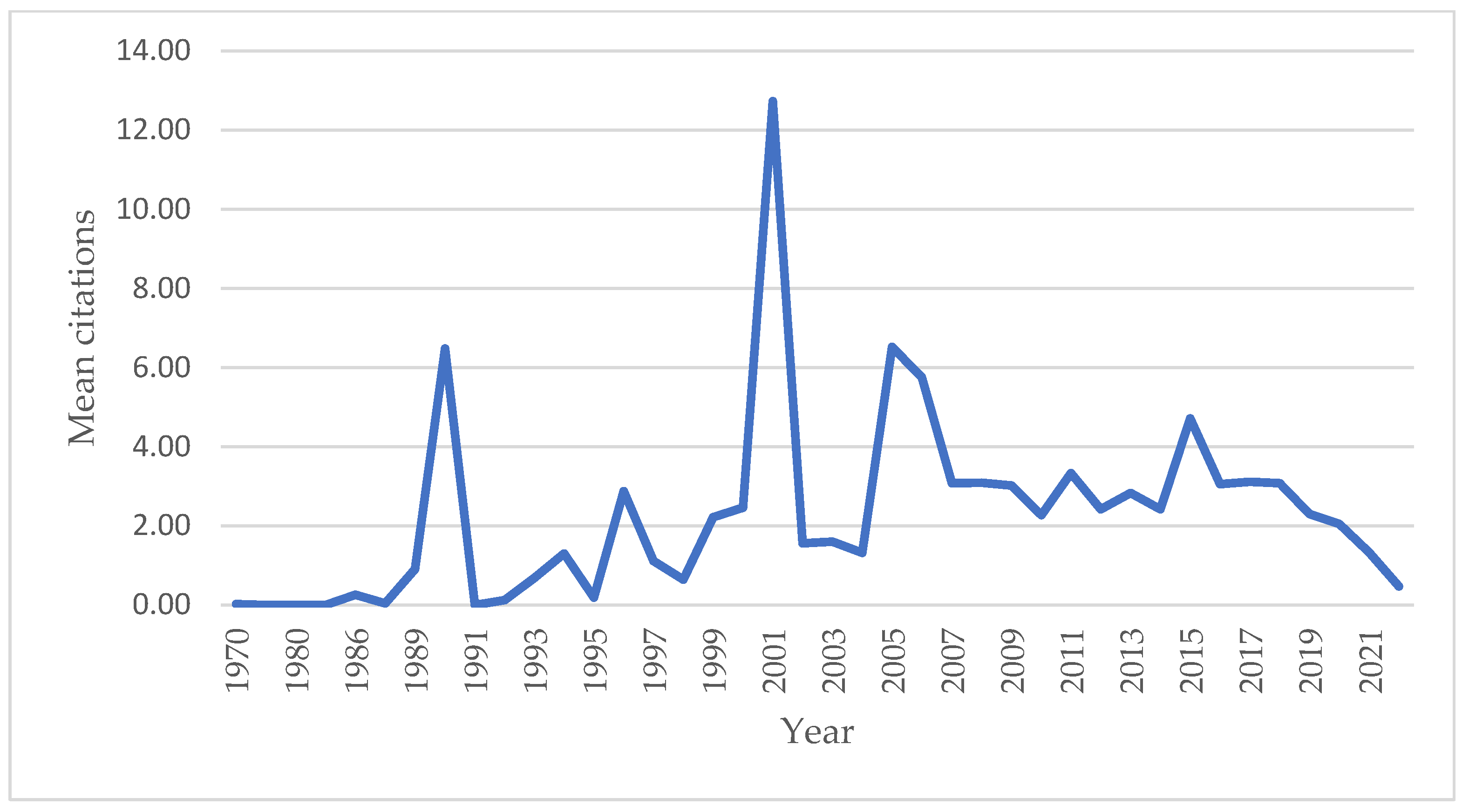
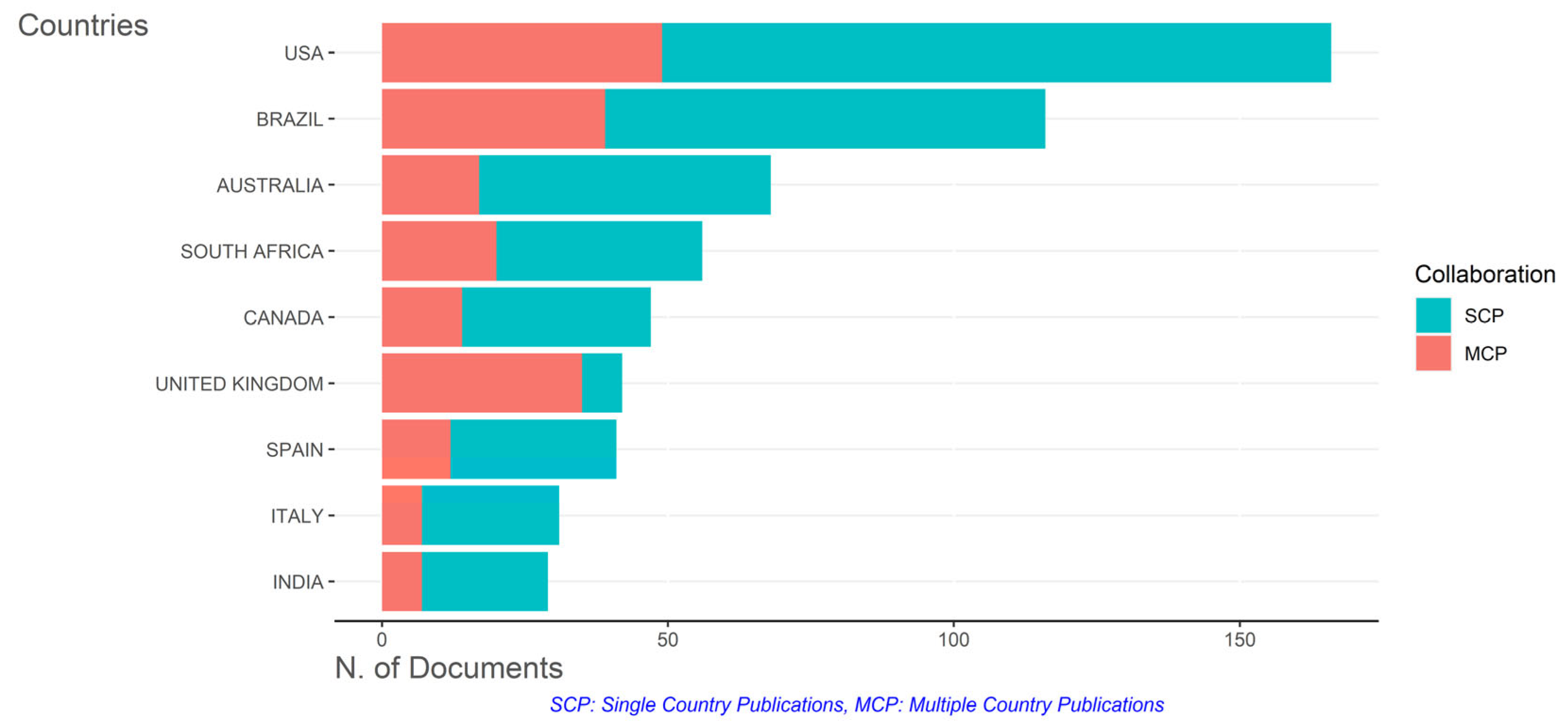
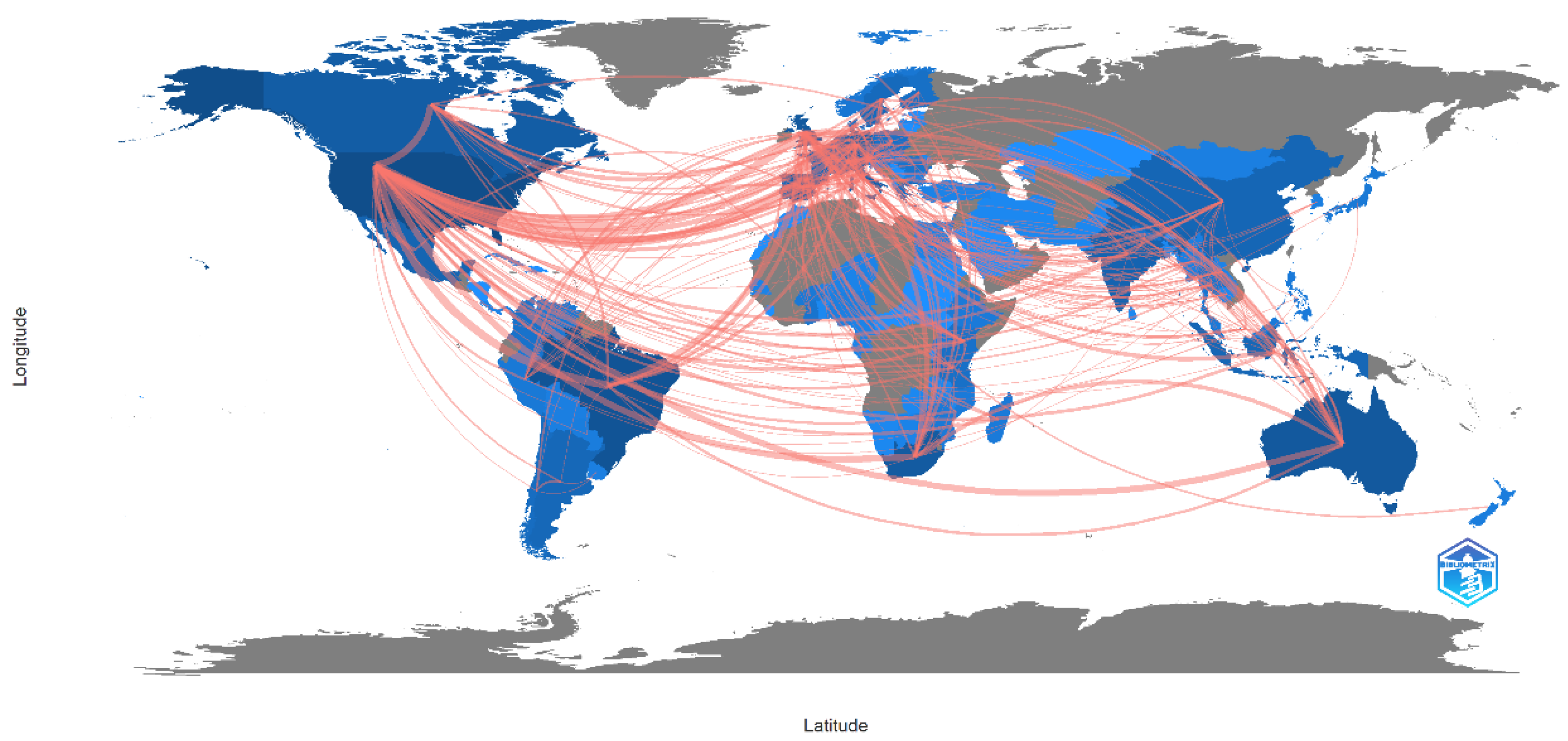
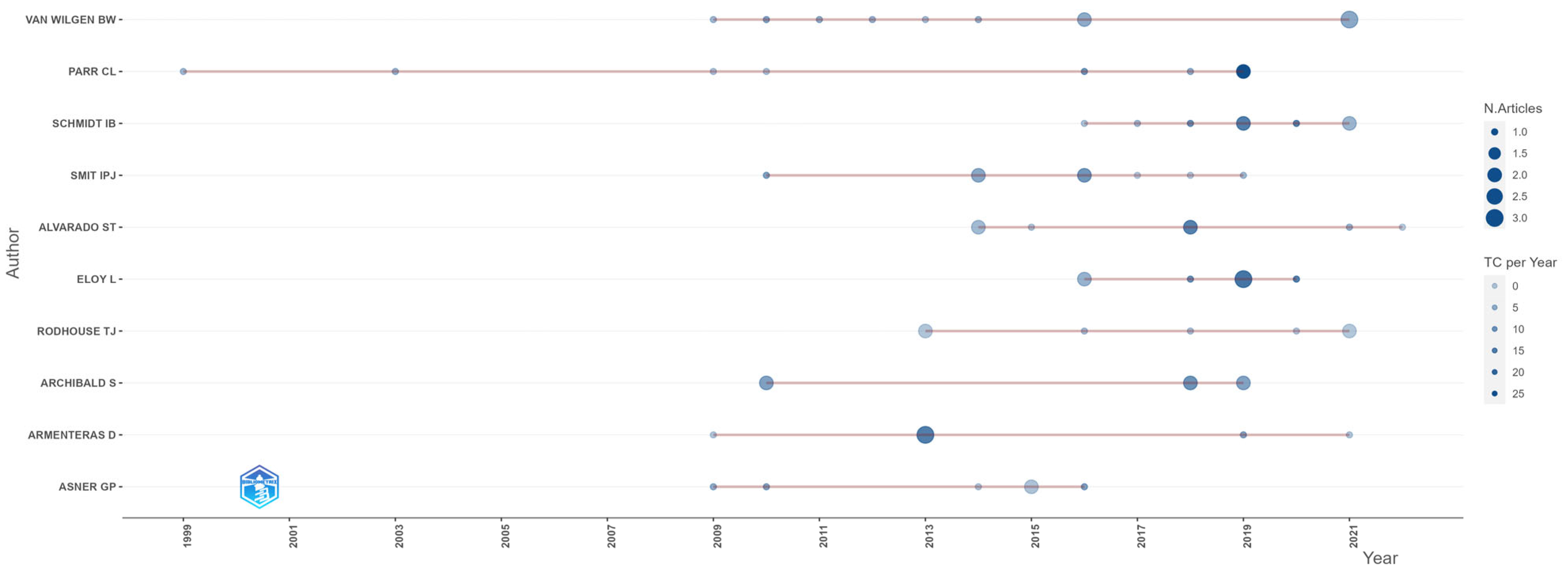
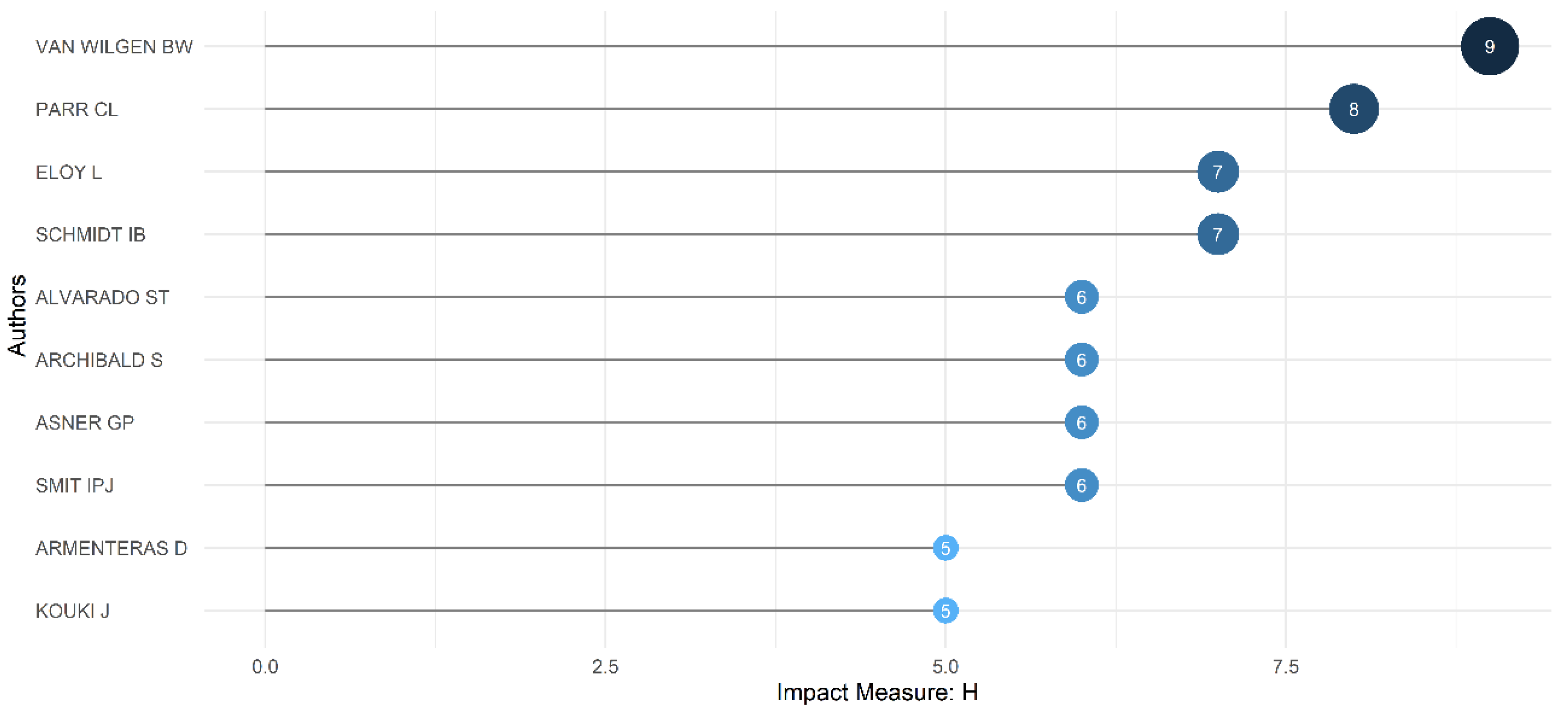
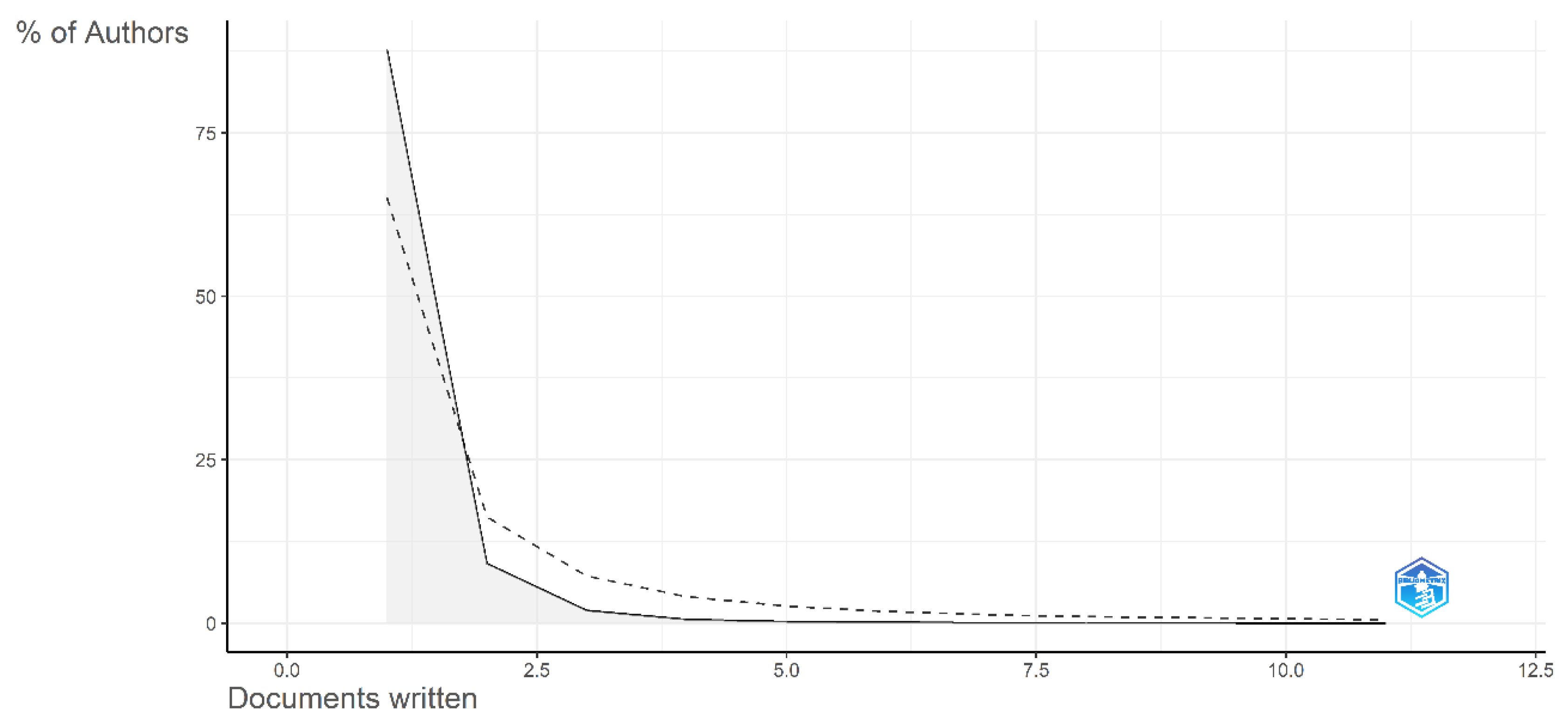

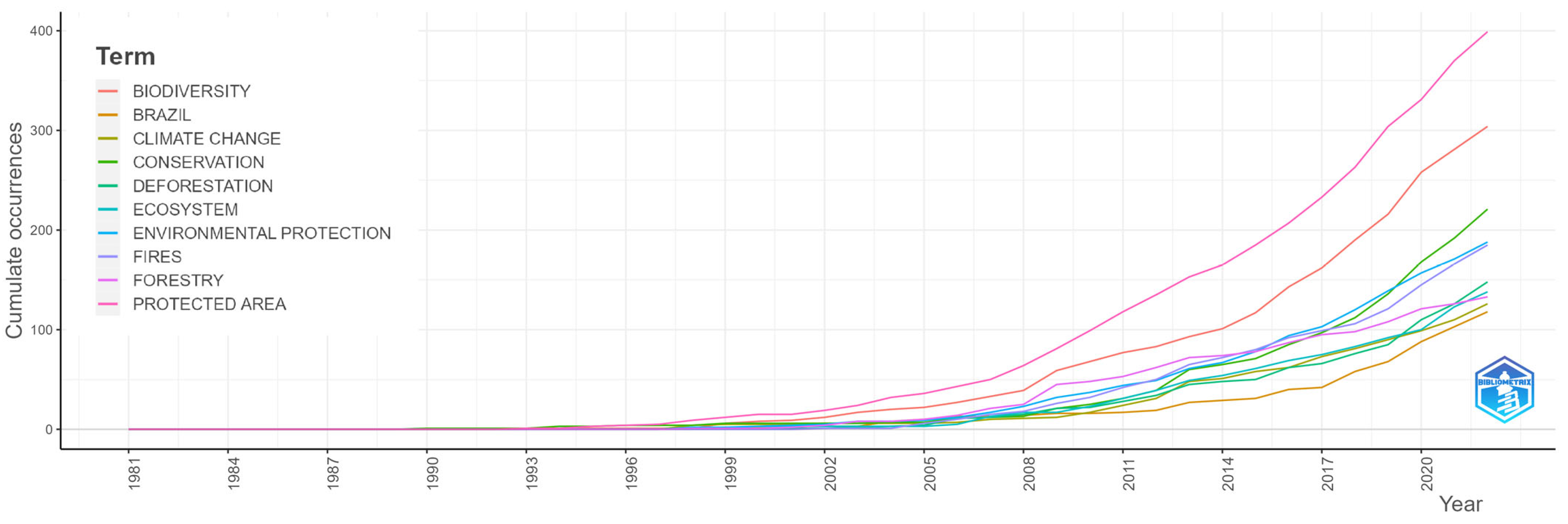
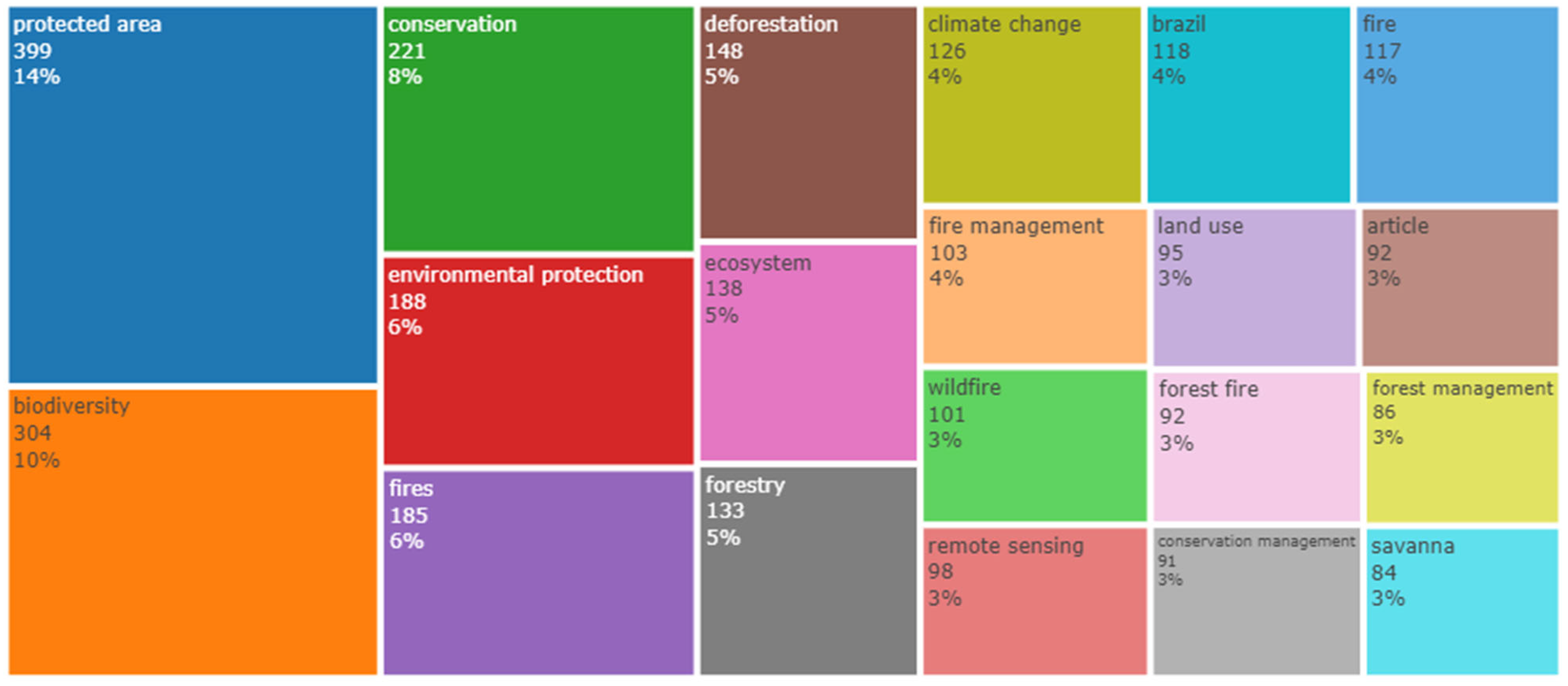

| Description | Results |
|---|---|
| Timespan | 1970–2022 |
| Sources | 527 |
| Documents | 1116 |
| Annual Growth Rate % | 9.36 |
| Average age of document | 8.58 |
| Average citations per doc | 26.53 |
| DOCUMENT CONTENTS | |
| Keywords Plus (ID) | 4905 |
| Author’s keywords (DE) | 3266 |
| AUTHORS | |
| Authors | 4419 |
| Authors of single-authored documents | 116 |
| AUTHORS’ COLLABORATION | |
| Single-authored docs | 128 |
| Co-authors per doc | 4.65 |
| International co-authorships % | 33.15 |
| DOCUMENT TYPES | |
| Article | 933 |
| Book | 1 |
| Book chapter | 52 |
| Conference paper | 62 |
| Conference review | 5 |
| Editorial | 1 |
| Letter | 3 |
| Note | 3 |
| Review | 54 |
| Short survey | 2 |
| Country | TC | Average Article Citations |
|---|---|---|
| USA | 7419 | 44.69 |
| Brazil | 3189 | 27.49 |
| United Kingdom | 2411 | 57.40 |
| Australia | 2054 | 30.21 |
| South Africa | 1908 | 34.07 |
| Canada | 1060 | 22.55 |
| Spain | 1032 | 25.17 |
| Germany | 640 | 26.67 |
| Finland | 607 | 50.58 |
| Tanzania | 583 | 83.29 |
| Affiliation | Articles |
|---|---|
| Stellenbosch University (South Africa) | 30 |
| University of the Witwatersrand (South Africa) | 25 |
| University of California (USA) | 22 |
| Scientific Services (United Kingdom) | 22 |
| University of Florida (USA) | 21 |
| University of Brasília (Brazil) | 19 |
| James Cook University (Australia) | 18 |
| Oregon State University (USA) | 17 |
| University of Pretoria (South Africa) | 17 |
| USDA Forest Service (USA) | 17 |
| From | To | Frequency |
|---|---|---|
| USA | United Kingdom | 32 |
| USA | Brazil | 30 |
| USA | Canada | 22 |
| USA | South Africa | 21 |
| Brazil | United Kingdom | 17 |
| USA | Australia | 17 |
| USA | Germany | 14 |
| Australia | United Kingdom | 12 |
| South Africa | United Kingdom | 12 |
| USA | France | 11 |
| Cluster | Callon’s Centrality | Callon’s Density | Rank Centrality | Rank Density | Cluster Frequency |
|---|---|---|---|---|---|
| savanna | 7.095 | 14.044 | 2 | 3 | 1559 |
| protected area | 10.493 | 13.652 | 4 | 2 | 3014 |
| environmental protection | 8.186 | 16.146 | 3 | 4 | 1610 |
| conservation | 5.342 | 12.374 | 1 | 1 | 1332 |
Disclaimer/Publisher’s Note: The statements, opinions and data contained in all publications are solely those of the individual author(s) and contributor(s) and not of MDPI and/or the editor(s). MDPI and/or the editor(s) disclaim responsibility for any injury to people or property resulting from any ideas, methods, instructions or products referred to in the content. |
© 2023 by the authors. Licensee MDPI, Basel, Switzerland. This article is an open access article distributed under the terms and conditions of the Creative Commons Attribution (CC BY) license (https://creativecommons.org/licenses/by/4.0/).
Share and Cite
Folharini, S.; Vieira, A.; Bento-Gonçalves, A.; Silva, S.; Marques, T.; Novais, J. Bibliometric Analysis on Wildfires and Protected Areas. Sustainability 2023, 15, 8536. https://doi.org/10.3390/su15118536
Folharini S, Vieira A, Bento-Gonçalves A, Silva S, Marques T, Novais J. Bibliometric Analysis on Wildfires and Protected Areas. Sustainability. 2023; 15(11):8536. https://doi.org/10.3390/su15118536
Chicago/Turabian StyleFolharini, Saulo, António Vieira, António Bento-Gonçalves, Sara Silva, Tiago Marques, and Jorge Novais. 2023. "Bibliometric Analysis on Wildfires and Protected Areas" Sustainability 15, no. 11: 8536. https://doi.org/10.3390/su15118536
APA StyleFolharini, S., Vieira, A., Bento-Gonçalves, A., Silva, S., Marques, T., & Novais, J. (2023). Bibliometric Analysis on Wildfires and Protected Areas. Sustainability, 15(11), 8536. https://doi.org/10.3390/su15118536










